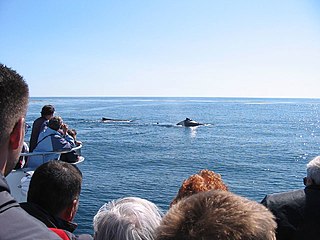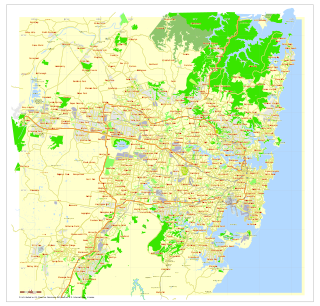Humpback migration
The humpback whale migration passing Sydney takes place between April and December each year. The season is split into two distinct sections depending on the direction of travel of the majority of whales at that time.

The humpback whale is a species of baleen whale. One of the larger rorqual species, adults range in length from 12–16 m (39–52 ft) and weigh around 25–30 metric tons. The humpback has a distinctive body shape, with long pectoral fins and a knobbly head. It is known for breaching and other distinctive surface behaviors, making it popular with whale watchers. Males produce a complex song lasting 10 to 20 minutes, which they repeat for hours at a time. All the males in a group will produce the same song which is different each season. Its purpose is not clear, though it may have a role in mating by inducing estrous.
The migrating population is named the Group 5 Southern Hemisphere humpback whale population or the Australian East coast humpbacks. As distinct from other humpback migration populations that travel along the West Australian and South African coasts.
The distance from the coast of the whales is believed to be based on the movements of the ocean currents, primarily the East Australian Current. The East Australian Current is a strong southerly current that the humpback whales make use of during their southern migration. On the Northern migration the Humpback whales will often use the Inshore Northern current, which is a north flowing counter current to the EAC. The main purpose of the annual humpback migration is to breed.
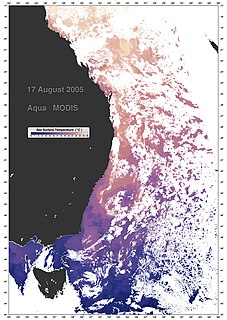
The East Australian Current (EAC) is the southward western boundary current that is formed from the South Equatorial Current (SEC) crossing the Coral Sea and reaching the eastern coast of Australia. At around 15° S near the Australian coast the SEC divides forming the southward flow of the EAC. It is the largest ocean current close to the shores of Australia. The EAC reaches a maximum velocity at 30° S where its flow can reach 90 cm/s. As it flows southward it splits from the coast at around 31° to 32° S. By the time it reaches 33° S it begins to undergo a southward meander while another portion of the transport turns back northward in a tight recirculation. At this location the EAC reaches its maximum transport of nearly 35 Sv. The majority of the EAC flow that does not recirculate will move eastward into the Tasman Front crossing the Tasman Sea just north of the cape of New Zealand. The remaining will flow south on the EAC Extension until it reaches the Antarctic Circumpolar Current. The Tasman Front transport is estimated at 13 Sv. The eastward movement of the EAC through the Tasman Front and reattaching to the coastline of New Zealand forms the East Auckland Current. The EAC also acts to transport tropical marine fauna to habitats in sub-tropical regions along the south east Australian coast.
For either migration the best shore locations to watch the whales are on high points along the coast, cliffs and headlands.
From South to North the best locations are:
Magic Point is a coastal headland in Maroubra, Sydney, New South Wales, Australia. It is about 10 km south of Sydney's central business district. It is a rugged heathland area with cliffs overlooking the ocean.
Spotting whales from elsewhere including directly off the beaches is quite possible, just less common.
Commercial whale watching tours run daily through the humpback seasons and can be boarded at Darling Harbour, Circular Quay and other wharfs around Sydney Harbour.
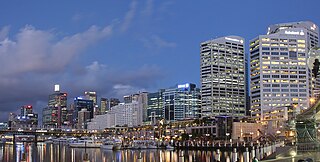
Darling Harbour is a harbour adjacent to the city centre of Sydney, New South Wales, Australia that is made up of a large recreational and pedestrian precinct that is situated on western outskirts of the Sydney central business district.

Circular Quay is a harbour, former working port and now international passenger shipping port, public piazza and tourism precinct, heritage area, and transport node located in Sydney, New South Wales, Australia on the northern edge of the Sydney central business district on Sydney Cove, between Bennelong Point and The Rocks. It is part of the local government area of the City of Sydney.
Northern migration
From April to mid August the Humpbacks are heading north to give birth and mate in the waters of the Coral Sea. At this time of year they tend to swim constantly north at 4-5 knots (5–9 km/h) and will have regular surface intervals.
At this time the whales are utilizing the Inshore Northern current to assist them on the way north. This current is usually found only within 3 nautical miles (5.6 km) of the coast, so most of the migrating population will pass within this distance. This is the easiest time for shore based spotters to see the full population of humpback whales passing by the Sydney coast as they head north.
Often on the Northern migration, especially when the currents are strong close to shore, a Humpback pod may enter the harbour for a short time. Normally they will leave again within a few hours and will rarely venture far from the harbour entrance.
Southern migration
From mid August to mid December the Humpbacks are heading south to return to the Antarctic feeding ground for the southern hemisphere summer. While they will tend southwards they may swim in any direction for hours at a time, with less consistent surface intervals.
At this time they generally swim slower than on the northern migration and use the East Australian Current to move them south. The EAC tends to begin around the 3-nautical-mile (5.6 km) line and may peak in strength up to 10-20 nautical miles from the coast. This means the Southern Humpback migration can sometimes be very difficult to spot from on shore.
However, during Early October to Mid December the mothers and newborn calves pass south, they tend to swim very close to the shoreline. Often they will stop in protected areas to close to beaches to rest and feed. [2]
Typical behavior
- Breaching
- Tail slapping
- Spyhops
- Mugging (approaching boats to inspect them)
- Feeding (mothers and calves)

Cook Strait is a strait that separates the North and South Islands of New Zealand. It connects the Tasman Sea on the northwest with the South Pacific Ocean on the southeast, and runs next to the capital city, Wellington. It is 22 kilometres (14 mi) wide at its narrowest point, and is considered one of the most dangerous and unpredictable waters in the world.
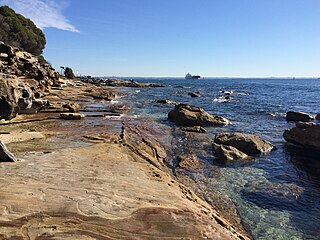
The Kamay Botany Bay National Park is a heritage-listed protected national park that is located in the Sydney metropolitan region of New South Wales, in eastern Australia. The 456-hectare (1,130-acre) national park is situated approximately 16 kilometres (9.9 mi) south-east of the Sydney central business district, on the northern and southern headlands of Botany Bay. The northern headland is at La Perouse and the southern headland is at Kurnell.

Right whales or black whales are three species of large baleen whales of the genus Eubalaena: the North Atlantic right whale, the North Pacific right whale and the Southern right whale. They are classified in the family Balaenidae with the bowhead whale. Right whales have rotund bodies with arching rostrums, V-shaped blowholes and dark gray or black skin. The most distinguishing feature of a right whale is the rough patches of skin on its head, which appear white due to parasitism by whale lice. Right whales can grow up to more than 18 m (59 ft) long with a highest-recorded length of 19.8 m (65 ft). Right whales are very robust whales, weighing 100 short tons or more. The largest known right whales can attain 20.7 m (68 ft) in length and weigh up to 135,000 kg (298,000 lb) or 21.3 m (70 ft) with uncertainty, Their immense bulk makes right whales significantly heavier than other whales of similar or greater length such as the humpback, gray, sperm and even fin whales. In fact, right whales rank only behind the blue whale in sheer body mass. One (apocryphal) explanation for their name is that whalers identified them as the "right" whale to kill on a hunt due to the plentiful oil and baleen they could provide.

The southern right whale is a baleen whale, one of three species classified as right whales belonging to the genus Eubalaena.
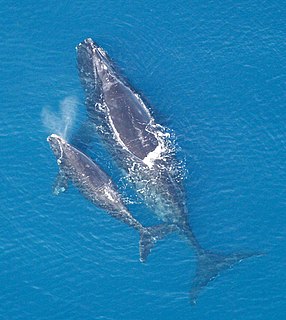
The North Atlantic right whale is a baleen whale, one of three right whale species belonging to the genus Eubalaena, all of which were formerly classified as a single species. Because of their docile nature, their slow surface-skimming feeding behaviors, their tendencies to stay close to the coast, and their high blubber content, right whales were once a preferred target for whalers. At present, they are among the most endangered whales in the world, and they are protected under the U.S. Endangered Species Act and Marine Mammal Protection Act and Canada's Species at Risk Act. There are about 400 individuals in existence in the western North Atlantic Ocean—they migrate between feeding grounds in the Labrador Sea and their winter calving areas off Georgia and Florida, an ocean area with heavy shipping traffic. In the eastern North Atlantic, on the other hand—with a total population reaching into the low teens at most—scientists believe that they may already be functionally extinct. Vessel strikes and entanglement in fixed fishing gear, which together account for nearly half of all North Atlantic right whale mortality since 1970, are their two greatest threats to recovery.

The dusky dolphin is a dolphin found in coastal waters in the Southern Hemisphere. Its specific epithet is Latin for "dark" or "dim". It is very closely genetically related to the Pacific white-sided dolphin, but current scientific consensus holds they are distinct species. The dolphin's range is patchy, with major populations around South America, southwestern Africa, New Zealand, and various oceanic islands, with some sightings around southern Australia and Tasmania. The dusky dolphin prefers cool currents and inshore waters, but can also be found offshore. It feeds on a variety of fish and squid species and has flexible hunting tactics. The dusky dolphin is known for its remarkable acrobatics, having a number of aerial behaviours. The status of the dolphin is unknown, but it has been commonly caught in gill nets.

Otago Harbour is the natural harbour of Dunedin, New Zealand, consisting of a long, much-indented stretch of generally navigable water separating the Otago Peninsula from the mainland. They join at its southwest end, 21 km (13 mi) from the harbour mouth. It is home to Dunedin's two port facilities, Port Chalmers and at Dunedin's wharf. The harbour has been of significant economic importance for approximately 700 years, as a sheltered harbor and fishery, then deep water port.

King George Sound is the name of a sound on the south coast of Western Australia. Originally named King George the Third's Sound, it was referred to as King George's Sound from 1805. The name "King George Sound" gradually came into use from about 1934, prompted by new Admiralty charts supporting the intention to eliminate the possessive 's' from geographical names.
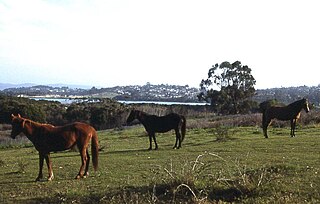
Eden is a coastal town in the South Coast region of New South Wales, Australia. The town is 478 kilometres (297 mi) south of the state capital Sydney and is the most southerly town in New South Wales, located between Nullica Bay to the south and Calle Calle Bay, the northern reach of Twofold Bay, and built on undulating land adjacent to the third-deepest natural harbour in the southern hemisphere, and Snug Cove on its western boundary. At the 2016 census, Eden had a population of 3,151.

False Bay is a body of water in the Atlantic Ocean between the mountainous Cape Peninsula and the Hottentots Holland Mountains in the extreme south-west of South Africa. The mouth of the bay faces south and is demarcated by Cape Point to the west and Cape Hangklip to the east. The north side of the bay is the low-lying Cape Flats. Much of the bay is on the coast of the City of Cape Town, and it includes part of the Table Mountain National Park Marine Protected Area and the whole of the Helderberg Marine Protected Area.
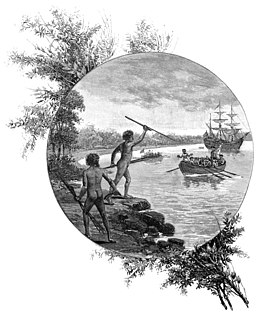
Kurnell is a suburb in Sydney, in the state of New South Wales, Australia. It is 21.4 kilometres (13.3 mi) south of the Sydney central business district, in the local government area of the Sutherland Shire along the east coast. Cronulla and Woolooware are the only adjacent suburbs. La Perouse is located opposite, on the northern headland of Botany Bay. The Cronulla sand dunes is on the south eastern headland of Botany Bay. The eastern side of the peninsula is part of Botany Bay National Park, and Towra Point Nature Reserve is located on the western side of the suburb.
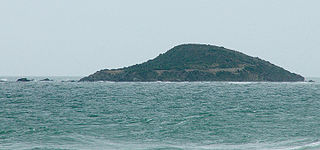
Moturata, also called Taieri Island, is an island in the mouth of the Taieri River in southern New Zealand. It is connected to the mainland by a sandy causeway at low tide.

Tourism in Sydney, Australia forms an important part of the city's economy. The city received 10.67 million domestic visitors and 4.05 million international visitors in year ending September 2018. The most famous attractions include the Sydney Opera House, and the Sydney Harbour Bridge. Other attractions include the Sydney Mardi Gras, Royal Botanical Gardens, Luna Park, the beaches and Sydney Tower.

Whaling was one of the first viable industries established in the Swan River Colony following the 1829 arrival of British settlers to Western Australia. The industry had numerous ups and downs until the last whaling station closed in Albany in 1978.
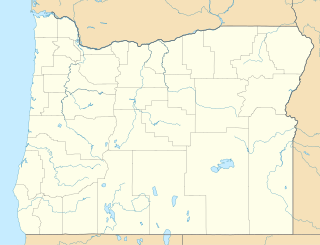
The Depoe Bay Whale Watching Center, also known as the Depoe Bay Ocean Wayside, is an Oregon State Parks-staffed visitor center in Depoe Bay, Oregon, U.S. to help visitors observe whale migration and provide information about whales and other marine mammals, including history, economics, and their environmental and ecological influences. The wayside provides a sheltered platform from which to view the ocean. First established as a wayside parking area on the Oregon Coast Highway in 1930, the wayside building was built in 1956 as a restroom facility for the popular spot. It is located just to the north of the Depoe Bay Bridge, also on the National Register.

There are at least 28 species of cetaceans — 7 baleen whales and 21 toothed whales — in Gulf of Guinea. Scientific approaches to cetacean diversities have not been taken until recently, and 18 species were confirmed during researches. Ghana’s coast of 550 km from Aflao to Axim is part of the Gulf of Guinea which has a humpback whale breeding stock with a population of over 10,000 individuals. These strandings show a peak abundance of breeding humpbacks in these waters. An increase in the strandings in recent years are a result of other population dynamics or an increase in human coverage and reporting.
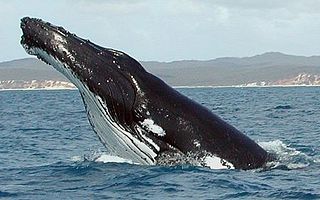
Whale watching in Australia is a popular recreational pursuit and a tourist activity along various coasts. In 2008, whale and dolphin watching was worth an estimated A$31 million in direct expenditure to the Australian economy with an estimated 1.6 million tourists participating in the activity. Whaling in Australia took place from 1788 to 1978 and was once commercially successful. The Australian Whale Sanctuary was established in 1999 to protect dolphins and whales from hunting. Humpback whales are the most common species seen in the waters surrounding Australia while southern right whales, minke whales and blue whales are also seen.
